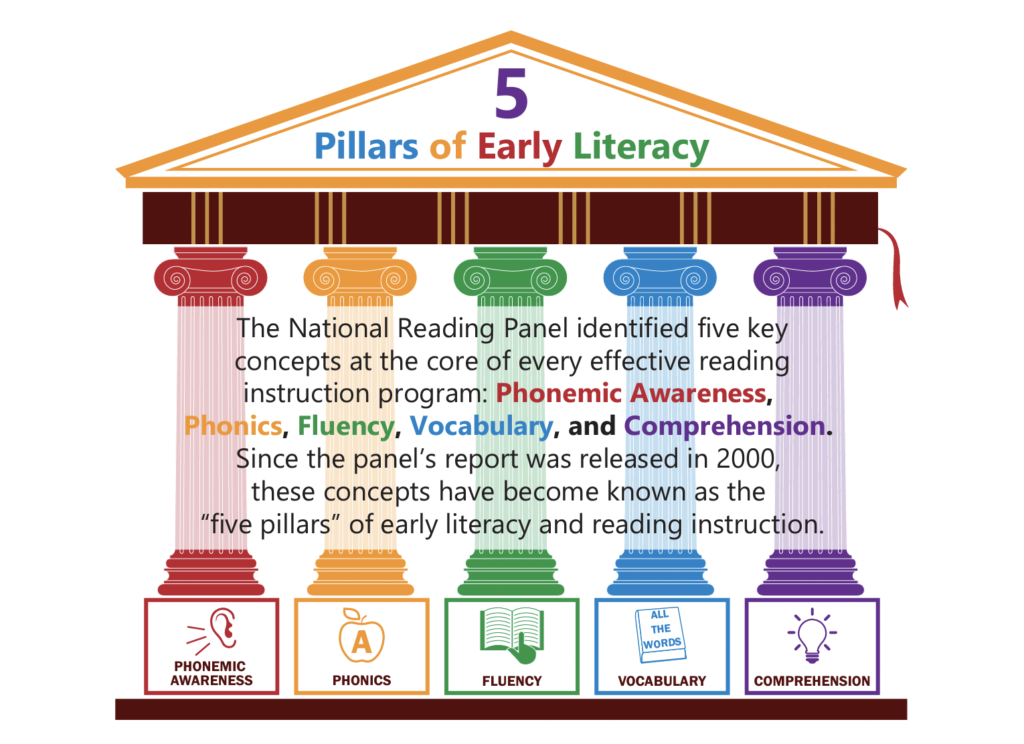Literacy instruction is the most important curriculum component of early childhood. Learning how to read, write and communicate effectively is the foundation for everything else in learning – like math, science, history, and so forth – is premised.
An essential skill, literacy is the number one marker for later success in life, both socially and academically. Studies show that kids with higher literacy levels are more likely to graduate from high school and college than those who do not have these skills. A softer skills side to literacy comes in the form of self-esteem and confidence as children mature and learn to handle more responsibility and independence.
According to the National Reading Panel, there are five essential components to literacy instruction: phonological awareness, phonics, fluency, vocabulary, and comprehension. These skills are interrelated and mutually supportive, requiring consistent practice and emphasis. When these elements are targeted and honed from the earliest moments, like when a parent reads to their child at bedtime, to reading out loud as a budding independent reader in kindergarten and throughout elementary school through quality reading programs, students will see improvements across all areas of literacy.
Here is a Quick Breakdown of the 5 Essential Components of Literacy
- Phonological awareness: The ability to hear sounds in words. It helps children learn how to blend sounds together to read words.
- Phonics: The understanding that letters represent individual sounds. It helps children recognize words when they see them, which helps them learn how to spell new words.
- Fluency: The ability to read smoothly and accurately with expression. Fluent readers can read a text accurately and with expression at their own pace.
- Vocabulary: The number of words your child knows and understands the meaning of. A large vocabulary will help your child become a better reader and writer!
- Comprehension: This means understanding what you have read or heard—that it makes sense and that you can relate it back to other things you know about or experience in life (like the plot of a story).
Teaching the 5 Essential Components of Literacy with Orton-Gillingham
There are various ways for educators to teach these literacy components. The most effective instruction educators should be using is systematic and explicit instruction. At IMSE, our favorite form of this type of instruction is the Orton-Gillingham methodology.
The Orton-Gillingham methodology combines direct, multi-sensory teaching strategies with systematic, sequential lessons focused on phonics. It was actually the very first approach to use explicit, direct, sequential, systematic, and multi-sensory instruction to teach reading.
Orton-Gillingham was among the first teaching approaches designed to help struggling readers by explicitly teaching the connections between letters and sounds. It combines auditory, visual, kinesthetic, and tactile activities like drawing letters in sand or shaving cream or saying letter sounds out loud as students trace letter shapes with their fingers, merged with regular literacy instruction in the classroom.
Skills are broken into smaller manageable parts and progressively built upon as students learn new concepts. For example, students may begin by making the connection between letters and sounds and building their phonological awareness skills. Next, they would use those letter sounds to form the relationship to build words and must master each skill before they move on to the next.
Incorporating a multi-sensory approach to reading instruction helps young learners utilize multiple pathways to further enforce what they are being taught. Uniquely, Orton-Gillingham is effective for all students and especially essential for teaching students with dyslexia and other learning disabilities.
Conclusion
Teaching students to read is the greatest responsibility an educator has. To help a student achieve this critical milestone, an educator must be prepared with the appropriate knowledge and tools, which involves a commitment to training and supplemental tutorials.
IMSE provides all the tools and resources educators need to make an impact on literacy in their classrooms. Not only does IMSE have professional development programs, but we also provide educators with:
- Physical and digital materials: these can be used in your classroom to implement IMSE strategies with your students
- IOG 2.0: our online lesson planning tool takes the guesswork out of daily lesson planning and makes life easier for IMSE-trained educators
- Ongoing support and resources: we are here to support you every step of the way so that you able to provide the very best literacy instruction to your students
Based on the latest research in the Science of Reading, IMSE Impact incorporates the Orton-Gillingham methodology and all five pillars of literacy – plus language comprehension, spelling, and writing – to begin driving measurable gains for all students in a classroom, beginning on day 1.
In parts 2-6 of this blog series, we will tackle each of the individual essential components of literacy instruction and provide you with a clear understanding of each of the five components.
Please connect with us on Facebook, Twitter, Instagram, LinkedIn, and Pinterest to get tips and tricks from your peers and us. Read the IMSE Journal to hear success stories from other schools and districts, and be sure to check out our digital resources for refreshers and tips.
Resources
- https://www.nichd.nih.gov/sites/default/files/publications/pubs/nrp/Documents/report.pdf
- https://files.eric.ed.gov/fulltext/ED512569.pdf
Stay tuned for parts 2-6:
- What Is Phonological Awareness? Part 2 of The Essential Components of Literacy
- What Is Phonics? Part 3 of The Essential Components of Literacy
- What Is Fluency? Part 4 of The Essential Components of Literacy
- What Is Vocabulary? Part 5 of The Essential Components of Literacy
- What Is Comprehension? Part 6 of The Essential Components of Literacy

